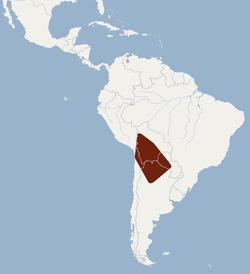Taxonomy and etymology
Thomas's big-eared brown bat was described as a new species in 1916 by British zoologist Oldfield Thomas. [2] Thomas described the species based on specimens held by the Turin Museum of Natural History that had been collected by "Dr. Borelli", [2] likely Dr. Alfredo Borelli, who furnished many biological specimens during this time from Argentina, Paraguay, and Bolivia. [3] The holotype had been collected in Caiza, Bolivia, which is located in the Potosí Department of Southern Bolivia. [2] Of the species name "laephotis", Thomas was not clear on its meaning, though he remarked that it "[had] a similar meaning" to the name histiotus, [4] which means "sail ear" (from Ancient Greek "ἱστός" meaning "mast" + "οὖς" meaning "ear"). [5] A hypothesis for the etymology of laephotis is that it comes from Greek "λαιός" meaning "awkward" and "φως" meaning "light," possibly referring to an awkward flight in the daylight. [6]
The validity of Thomas's big-eared brown bat as a species has been disputed. In the past, it has been regarded as a subspecies of the big-eared brown bat, H. macrotis. [7] More recently, it has been considered a subspecies of the small big-eared brown bat, H. montanus. [8] At present, several sources consider it a valid species. [9] [10]
This page is based on this
Wikipedia article Text is available under the
CC BY-SA 4.0 license; additional terms may apply.
Images, videos and audio are available under their respective licenses.


